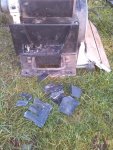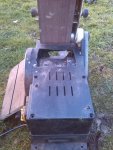I'm thinking of investing in a bench grinder to put primary bevels on chisels and plane blades. Whilst my local DIY shop offers a sharpening service I think in the long run I'm better using my limited budget to buy a grinder to do it myself. Also, I can do it when I want to and not have to wait for the week's turn-around time.
I've watched some YouTube footage and the consensus appears to be to head for a bench grinder of some sort, Whilst the Tormek and Sorby offerings are very professional. they are also quite pricey. There appear to be other options like the Axminster AC150BG and AC200BG outfits. However, as always, I want to make my money to go as far as possible and I'd like to be able to do slightly lower precision work like re-profiling cold chisels and re-vamping screwdrivers that I've chipped or used for years to get paint lids off! I'm looking for a system that has a good tool stand and a way of getting a precise angle on the bevel so some sort of jig?
I have bought a diamond stone and a very nice honing-guide set from Trend to be used with a final touch-up on a strop for the secondary bevel.
I'd appreciate any advice or experience on bench grinders (presumably slow speed ones?), wheels and can I do all my intended tasks on one machine?
Thanks in anticipation.
I've watched some YouTube footage and the consensus appears to be to head for a bench grinder of some sort, Whilst the Tormek and Sorby offerings are very professional. they are also quite pricey. There appear to be other options like the Axminster AC150BG and AC200BG outfits. However, as always, I want to make my money to go as far as possible and I'd like to be able to do slightly lower precision work like re-profiling cold chisels and re-vamping screwdrivers that I've chipped or used for years to get paint lids off! I'm looking for a system that has a good tool stand and a way of getting a precise angle on the bevel so some sort of jig?
I have bought a diamond stone and a very nice honing-guide set from Trend to be used with a final touch-up on a strop for the secondary bevel.
I'd appreciate any advice or experience on bench grinders (presumably slow speed ones?), wheels and can I do all my intended tasks on one machine?
Thanks in anticipation.






